Trading card games (TCGs) are known for being money pits. You can spend infinity dollars on games like Pokémon or Magic The Gathering. But amongst all the gimmicky accessories and things that are just nice to have, there are some essential accessories that mean you’ll have a better experience. So, here is my guide to the different kinds of TCG accessories, how they’re used, and what kind you need.
As a heads up, I’ve been a Magic The Gathering player for roughly 12 years, so a lot of this advice will be from that perspective (though, the majority is applicable to any card game as long as you buy the accessories in the correct size).
What kinds of accessories are out there?
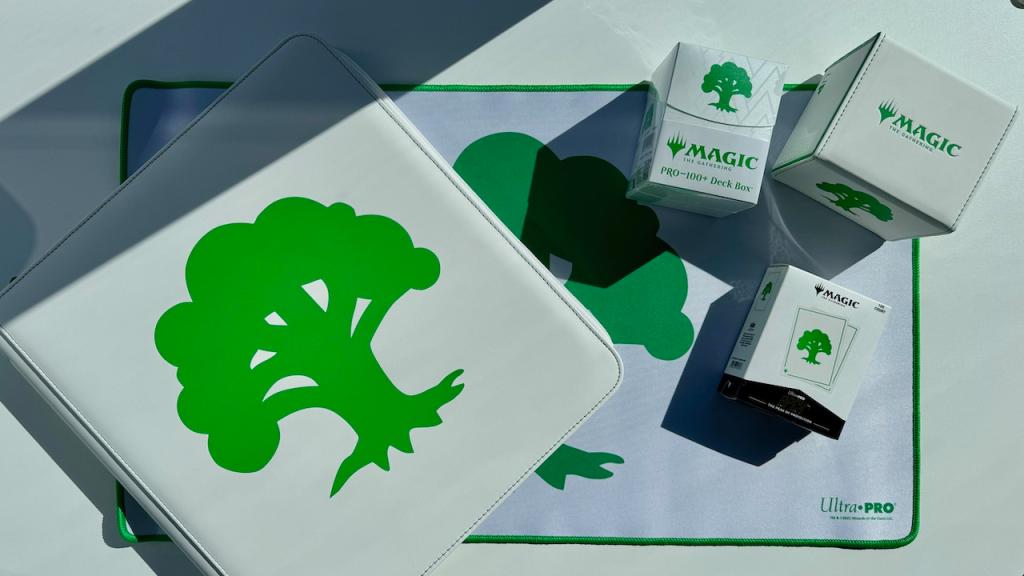
Technically, to play a TCG, you just need your deck, and everything else is gravy. But the more you play with unsleeved cards, the rattier they’re going to look, and the less likely you’ll be able to play in tournaments because your cards will look marked. TCG cards can also be worth a pretty penny, so it’s important to protect your investment. So, really, the bare minimum you need is sleeves. But then you also have to keep your deck neat and together to and from events, and while I’ve seen some incredible players show up with their deck held together with a rubber band, I’ve also seen how much that messes up their cards, so you’ll also need a deck box.
From there, you’ll need a way to keep score, which you can do with a pencil and paper or a bunch of other accessories, though both will have the same effect. You can also just play on a bare table or have a play mat down to keep things nice. If you trade and/or collect valuable cards you’re not playing with at the time, a trade binder is really useful. Plus, you’ll also want storage for other cards that you may or may not end up deck-building with. From there, you’ve got dice, tokens, counters, and storage for all of it.
For a lot of that stuff, you can really just use any box, paper, dice, or card binder. When I first started playing, I used binder pages from my Buffy and Xena trading card binders. But a large part of any hobby is enjoying the nice-to-haves as well as the essentials if they fit into your budget. Having a full matching set of deck box, binder, sleeves and play mat just looks so nice and clean that it’s a good treat to have.
Sleeves
As mentioned above, sleeves are essential, and there are a lot of different types that serve different purposes. Before we dive into the different varieties, I want to point out here that different card games have different card sizes. Pokémon and Magic the Gathering both use “standard” size, while Yu-Gi-Oh and some other Japanese TCG games use slightly smaller cards and thus sleeves (known as “Japanese size”), then there are just regular trading cards, like sports trading cards, which are a slightly larger size. The idea behind the sleeves is basically the same, but you’ll just want to make sure you buy the right size.
Another thing to look for when buying sleeves is that they’re PVC and acid-free. Some of the cheaper knockoff sleeves can actually damage your cards if left in there long enough, which kind of defeats the purpose
Inner sleeves – aka penny sleeves, perfect fit sleeves
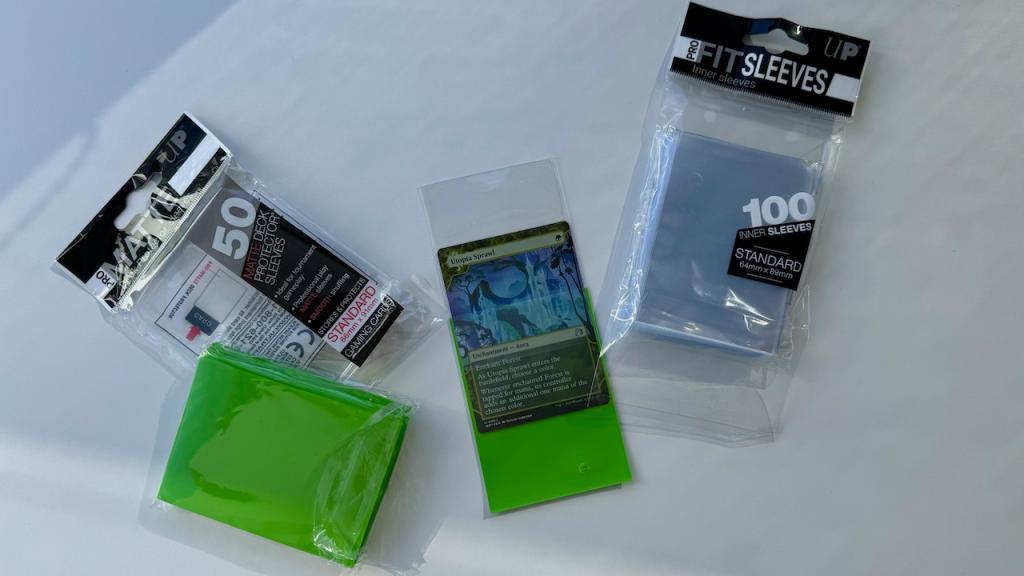
These are the cheapest type of sleeves, and they’re usually used in addition to regular sleeves for cards and decks you’re extra protective of. Cards I put in my trade binder go in an inner sleeve and then in the binder, and decks that have one or more particularly valuable cards get inner sleeves as well as regular ones (the whole deck gets sleeved identically, so even the basic lands get inner and outer sleeves, so you’re not accidentally marking cards).
Inner sleeves can technically be used as outer sleeves, and they have a lower upfront cost which makes them attractive to the budget conscious for this purpose, but they’re not as tough as regular sleeves, so you’ll go through more of them if you use them solo.
There are a few different types of inner sleeves and ways of using them – the usual kind (most commonly the Ultra Pro Pro-Fit Standard Deck Inner Sleeves) is a bottom loading sleeve that looks like a regular sleeve, but clear and small. You put the card in with the opening ending up at the bottom, and then put the regular sleeve on over the top with the opening at the top, so then the top and bottom of the card is extra protected.
There are also side-loading inner sleeves which have the same general idea, but in my opinion offer a little less protection because of the size of the hole.
Then, for the ultimate protection, there are sleeves like the Dragon Shield Sealable Perfect Fit sleeves which have a sealable flap which means you’re even less likely to damage your deck by tipping over a glass of water during play. But I do find that the sealable inner sleeves end up with more air trapped in them than I’d like, making them a little fiddly to put on and uncomfortable to play with them. Post Malone should definitely be using them on his One Ring card, but if you don’t have, say, a Black Lotus, you’ll be fine with regular inner sleeves if you don’t feel up to the fuss.
Matte Sleeves
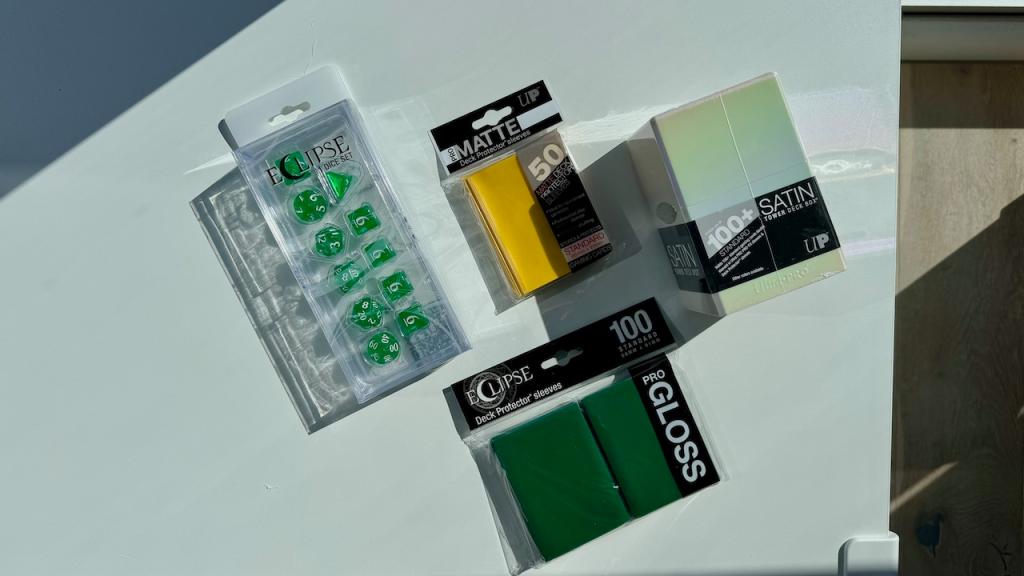
These are the most common type of outer sleeve, and you can get them in so many different colours and patterns. They’ll usually have one matte side that’s colourful (to hide if your card back has gotten damaged, or if you have a double-sided card in your deck, and also just to add personal flair), and a gloss clear side so you can actually see the card. Sometimes the back will be clear, sometimes the front will be matte instead of gloss. The matte front does make the deck a bit more structurally sound (especially if you’re playing commander with double sleeved cards), but some people (me) think a matte front looks hideous and makes it hard to read the card. A clear back is down to personal preference.
It’s cheeky that a lot of standard-size matte sleeves are sold in 50 packs, given both Pokémon and Magic The Gathering deck sizes are usually 60 cards. So, keep an eye on that when you’re buying sleeves.
Gloss Sleeves
If you don’t like the matte look, you can buy gloss sleeves. They’re the same as matte sleeves, but the colourful side is glossy. On the one hand, they have a slightly different aesthetic, which can look really good. On the other hand, they hate you and your entire family. I once sleeved a full commander deck with gloss sleeves, and there was no grip at all. This double sleeved monstrosity was so tall, and the sleeves so glossy and thus slippery that the top of my deck kept slipping off. They’re fine for the smaller deck sizes of Yu-Gi-Oh and constructed MTG play, but once you get to decks larger than, say, 50 cards, I don’t think it’s worth the extra work. Learn from my mistakes.
Top Loaders
These are those thick, heavy plastic sleeves you see on expensive trading cards. I have a few Ultra Pro top loaders that I use for some of my Xena TCG cards, as well as my Xena and Buffy collector cards, not to mention my Chris Paul and Blake Griffin rookie cards. I also use a couple for the commanders I’m particularly attached to.
These generally aren’t for every day play unless you’re trying to make some kind of point, but they are good to keep your commander separate from the rest of your deck, or really extra protecting valuable cards you plan to sell. If you have a first edition Charmander that you haven’t yet gotten graded (and don’t have any grading sleeves on hand), you’ll want to double-sleeve it and put it in a top loader.
Following along that same idea, you can also get One-Touch and Stand sleeves from Ultra Pro which will not only lovingly cradle your valuable card, but also stand it up so you can admire it from an appropriate distance. The One-Touch Stand is more of a middle ground between a graded card sleeve and a top loader, it’s still a nice thing to know about if there’s a card that’s particularly important to you that you don’t want to play.
Deck boxes
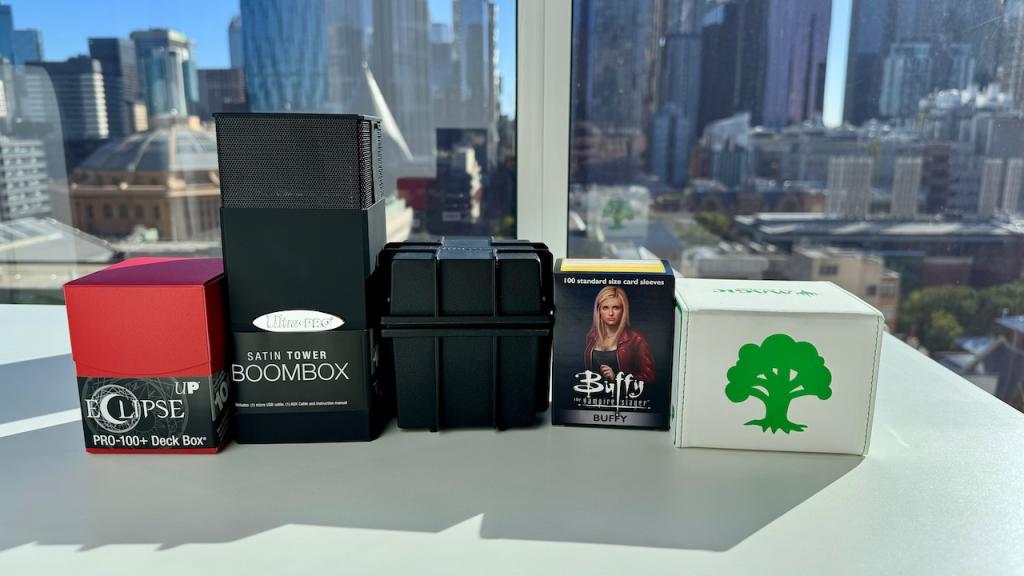
Deck boxes are boxes in which you place your deck. Whereas sleeves are fairly standardised, deck boxes are where things start to get creative and even sometimes deeply weird. I’m going to talk about them in three different categories, but off the bat just know that the sizes vary wildly, and a Yu-Gi-Oh deck, a Pokémon deck, MTG standard deck and an MTG Commander deck will need different sizes. That’s even before you start factoring in single and double-sleeved decks, which will add extra bulk.
Simple deck boxes
These simple deck boxes will be the cheapest you’ll find, but they’ll do the job just as well. These can be just a regular cardboard box that’s roughly the shape of your deck (12 years ago they were $2, so they’re probably around $40 now), or a thin plastic deck box. They come in a range of colours, you can get the Ultra Pro ones for around $5, and they last a long long time (we have a bunch of them in the PAX Together Lounge game library, and most of them have been there for all ten years I’ve worked the show, and they are not treated well).
But if you’re just after simple and also buying sleeves, some sleeves come with cardboard deck boxes. Dragon Shield sleeves, for example, come with a quite nice and basic box, same with Arcane Tinmen Board Game Sleeves. Ultra Pro Apex sleeves also come with a small box, but wouldn’t hold a full 60 card, fully sleeved deck.
Nice deck boxes
When you want to step it up a bit, there are some really lovely deck boxes that are a pleasure to use and will last a bit longer. Deck boxes in this tier cost $25-$100, and will offer a bit more protection for your deck, but they’re also just aesthetically and texturally pleasing. Some also have extra little storage areas, like the Ultra Pro Satin Tower Deck Box, which also has a little box to store dice. I really like the Ultra Pro Alcove Edge boxes (around $55), because they’re plush, and they have a little fold over lid that’s satisfying to use. I have a bunch of decks in the Satin Towers, for the dice storage, but my favourite decks are treated to the Alcove Edge boxes.
Deck boxes with extra features
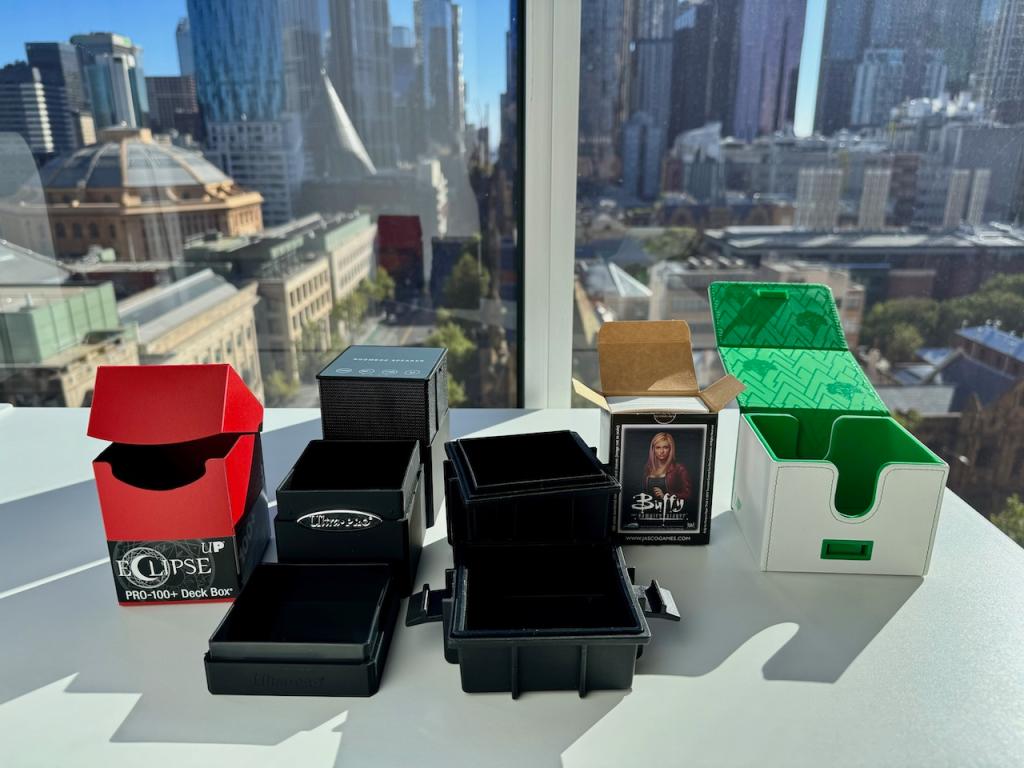
But, like all hobby accessories, some of these can get weird in fun ways. I have an Ultra Pro Waterproof Deck Box, which is nigh uncrushable, and IPX7 rated, so I can put it in the same backpack as a bottle of water without being stressed. Sometimes I use it to transport jewellery in my checked luggage when I travel. You can get deck boxes with built-in Bluetooth speakers, for some reason. There are also long storage boxes in the style of the Ultra Pro Alcove Edge Boxes which will hold multiple decks, either separated by tabs or with them all in the simple deck boxes, which is just a neater experience when rocking up to the store or a friends’ house.
Binders
At the start of your TCG journey, you will think that one binder is more than enough. Then in a couple of years, you’ll buy a second one. I don’t want to count how many I have and use now. I like to have one for trades, two for cards I find pretty, one for cards I intend to build decks around one day, and then some misc.
You can just use a regular ring binder with some loose trading card sleeves, if you like. I had that for years. But through trial and error I’ve found that a zippered binder is best. It offers more security, marginally more protection from spills, and it looks a bit neater. You’re usually going to keep your most valuable cards in this binder, so if you’re serious about your game, it’s worth making a proper investment.
Play mats
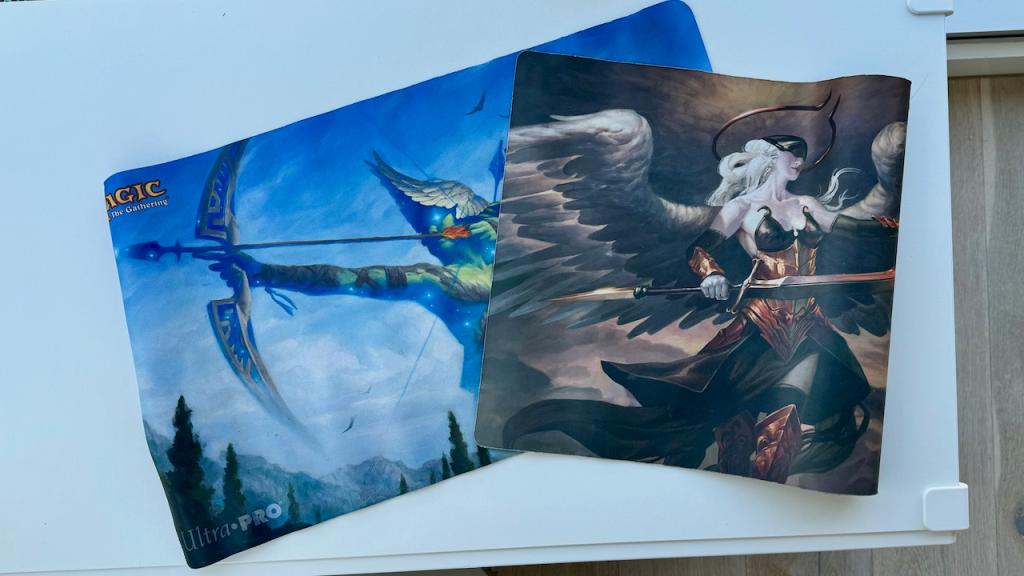
Play mats aren’t essential if you only ever play on nice, large tables that stay clean. But if you are playing somewhere that might have sticky tables (bar/restaurant, your friend’s share house, at a picnic) or if your friend just ends up hogging the table by putting out 1000 creatures and spreading out (I am the friend), then a play mat keeps your cards nice and marks out a section of the table that is yours.
Most play mats have a rubberised bottom with a fabric top, and usually just show off some card art. I have some with card art that I really like, and I have others that match my deck box, binder and sleeves which has the same vibe as your grandmother’s matching fine china set, but for nerds.
For newer players, and players of more regimented TCGs, you can get play mats that mark where different zones of play are. I found that really helpful for Star Wars Unlimited, because I knew where my space and ground troops were.
Other accessories
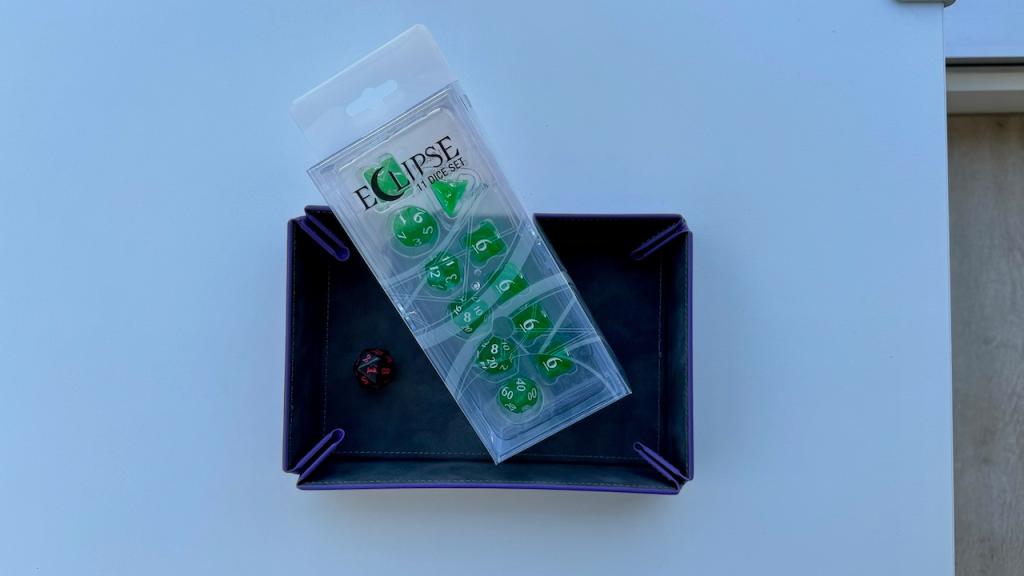
After that, it really depends on your game. For Magic The Gathering, you can get fancy tokens from artists at conventions and tournaments, which can be really nice.
For a lot of games you’ll need dice, either for keeping track of your score, or for counters. If your game involves rolling dice, I highly recommend a dice tray or dice tower just to keep it neat.
One thing I saw recently was an official notebook for keeping track of life totals in Magic the Gathering. You can do this with any piece of paper, but it was nice to have it all laid out.
You can also just use an app on your phone, but it can be good to sometimes just take screens out of the equation for a while, and paper and pencil means you can see how you got to where you are now.
Overall, though, the most important thing is that you have fun. If that fun means you just want to focus on the naked cards, you do you. If part of the fun for you is accessorising and protecting your investment, then enjoy that.
I’ve mostly used Ultra Pro as examples because I prefer it and have a lot of it on hand, so it’s easier to take photos to show what I mean, but there are lots of other brands out there and it’s probably going to take you a couple of goes to find the sleeves you like the feel of the most. I certainly didn’t get it right the first few times, because I started off being too cheap, overcorrected to too expensive (which I still didn’t like), and then discovered that I prefer Ultra Pro and Dragon Shield, so I’ve mostly stuck to them since, aside from when faced with a particularly pretty or nostalgic sleeve pattern. Fairly soon, you’ll have a favourite, too.

Leave a Reply